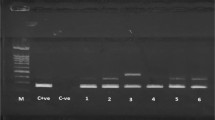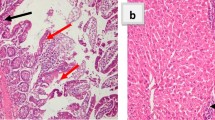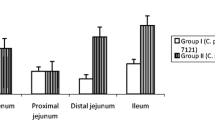Abstract
Cryptosporidium parvum is a zoonotic protozoan parasite having peculiarities among the apicomplexa that could be responsible for its resistance to some drugs and disinfectants against coccidia. The awareness of Cryptosporidium as a health problem in man and animal is increasing and potent drugs are urgently needed. Curcumin, a natural polyphenolic compound, has been found to be active against a variety of diseases including anticarcinogenic, antimicrobial, and antiprotozoal effects. We investigated the effects of curcumin on infectivity and development of C. parvum in a recently established in vitro system combining infection of human ileocecal adenocarcinoma cell cultures with quantification of intracellular parasites by quantitative polymerase chain reaction. Curcumin was found to be effective (>95% inhibition of parasite growth) at 50 µM for 24 h when infected cultures were exposed for more than 12 h. Withdrawal of curcumin after 24 h of exposure did not result in a significant resumption of C. parvum growth. The invasion of host cells by sporozoites (infectivity) was found to be inhibited at least 65% in the presence of 200 µM curcumin. No significant reduction of viability of C. parvum oocysts after incubation with curcumin was recorded. Altogether, curcumin showed promising anticryptosporidial effects under in vitro conditions and deserves further exploration.






Similar content being viewed by others
References
Ammon HP, Wahl MA (1991) Pharmacology of Curcuma longa. Planta Med 57:1–7
Araujo CC, Leon LL (2001) Biological activities of Curcuma longa L. Mem Inst Oswaldo Cruz 96:723–728
Araujo CAC, Alegrio LV, Castro D, Lima MEF, Leon LL (1998) Leishmania amazonensis: in vivo experiments with diarylhetanoids from Leguminosae and Zingiberaceae plants. Mem Inst Oswaldo Cruz 93:306–310
Bhaumik S, Anjum R, Rangaraj N, Pardhasaradhi BV, Khar A (1999) Curcumin mediated apoptosis in AK-5 tumor cells involves the production of reactive oxygen intermediates. FEBS Lett 456:311–314
Blackburn BG, Craun GF, Yoder JS, Hill V, Calderon RL, Chen N, Lee SH, Levy DA, Beach MJ (2004) Surveillance for waterborne-disease outbreaks associated with drinking water—United States, 2001–2002. MMWR Surveill Summ 53:23–45
Blasius R, Duvoix A, Morceau F, Schnekenburger M, Delhalle S, Henry E, Dicato M, Diederich M (2004) Curcumin stability and its effect on glutathione S-transferase P1-1 mRNA expression in K562 cells. Ann NY Acad Sci 1030:442–448
Cao J, Jia L, Zhou HM, Liu Y, Zhong LF (2006) Mitochondrial and nuclear DNA damage induced by curcumin in human hepatoma G2 cells. Toxicol Sci 91:476–483
Casemore DP, Wright SE, Coop RL (1997) Cryptosporidiosis—human and animal epidemiology. In: Fayer R (ed) Cryptosporidium and cryptosporidiosis. CRC, Boca Raton, pp 65–92
Chauret C, Boardman R (1998) Inactivation of Cryptosporidium parvum by Reactive Oxygen Species Generated by Ultraviolet Irradiation. In: WQTC1998–1998, Water Quality Technology
Cui L, Miao J, Cui L (2007) Cytotoxic effect of curcumin on malaria parasite Plasmodium falciparum: inhibition of histone acetylation and generation of reactive oxygen species. Antimicrob Agents Chemother 51:488–494
Darkin-Rattray SJ, Gurnett AM, Myers RW, Dulski PM, Crumley TM, Allocco JJ, Cannova C, Meinke PT, Colletti SL, Bednarek MA, Singh SB, Goetz MA, Dombrowski AW, Polishook JD, Schmatz DM (1996) Apicidin: a novel antiprotozoal agent that inhibits parasite histone deacetylase. Proc Natl Acad Sci U S A 93:13143–13147
Das R, Roy A, Dutta N, Majumder HK (2008) Reactive oxygen species and imbalance of calcium homeostasis contributes to curcumin induced programmed cell death in Leishmania donovani. Apoptosis 13:867–882
Duvoix A, Blasius R, Delhalle S, Schnekenburger M, Morceau F, Henry E, Dicato M, Diederich M (2005) Chemopreventive and therapeutic effects of curcumin. Cancer Lett 223:181–190
Entrala E, Mascaro C, Barrett J (1997) Anti-oxidant enzymes in Cryptosporidium parvum oocysts. Parasitology 114(Pt 1):13–17
Huang MT, Lysz T, Ferraro T, Abidi TF, Laskin JD, Conney AH (1991) Inhibitory effects of curcumin on in vitro lipoxygenase and cyclooxygenase activities in mouse epidermis. Cancer Res 51:813–819
Huang MT, Newmark HL, Frenkel K (1997) Inhibitory effects of curcumin on tumorigenesis in mice. J Cell Biochem Suppl 27:26–34
Koide T, Nose M, Ogihara Y, Yabu Y, Ohta N (2002) Leishmanicidal effect of curcumin in vitro. Biol Pharm Bull 25:131–133
Kuttan G, Kumar KB, Guruvayoorappan C, Kuttan R (2007) Antitumor, anti-invasion, and antimetastatic effects of curcumin. Adv Exp Med Biol 595:173–184
Leitch GJ, Qing HE (1999) Reactive nitrogen and oxygen species ameliorate experimental cryptosporidiosis in the neonatal BALB/c mouse model. Infect Immun 67:5885–5891
Liu HL, Chen Y, Cui GH, Zhou JF (2005) Curcumin, a potent anti-tumor reagent, is a novel histone deacetylase inhibitor regulating B-NHL cell line Raji proliferation. Acta Pharmacol Sin 26:603–609
Liu J, Mori A (1993) Antioxidant and pro-oxidant activities of p-hydroxybenzyl alcohol and vanillin: effects on free radicals, brain peroxidation and degradation of benzoate, deoxyribose, amino acids and DNA. Neuropharmacology 32:659–669
Mehta K, Pantazis P, McQueen T, Aggarwal BB (1997) Antiproliferative effect of curcumin (diferuloylmethane) against human breast tumor cell lines. Anticancer Drugs 8:470–481
Najdrowski M, Heckeroth AR, Wackwitz C, Gawlowska S, Mackenstedt U, Kliemt D, Daugschies A (2007) Development and validation of a cell culture based assay for in vitro assessment of anticryptosporidial compounds. Parasitol Res 101:161–167
Nose M, Koide T, Ogihara Y, Yabu Y, Ohta N (1998) Trypanocidal effects of curcumin in vitro. Biol Pharm Bull 21:643–645
Ohta T (1993) Modification of genotoxicity by naturally occurring flavorings and their derivatives. Crit Rev Toxicol 23:127–146
Perez-Arriaga L, Mendoza-Magana ML, Cortes-Zarate R, Corona-Rivera A, Bobadilla-Morales L, Troyo-Sanroman R, Ramirez-Herrera MA (2006) Cytotoxic effect of curcumin on Giardia lamblia trophozoites. Acta Trop 98:152–161
Pollok RC, McDonald V, Kelly P, Farthing MJ (2003) The role of Cryptosporidium parvum-derived phospholipase in intestinal epithelial cell invasion. Parasitol Res 90:181–186
Rao CV, Rivenson A, Simi B, Reddy BS (1995) Chemoprevention of colon carcinogenesis by dietary curcumin, a naturally occurring plant phenolic compound. Cancer Res 55:259–266
Reddy RC, Vatsala PG, Keshamouni VG, Padmanaban G, Rangarajan PN (2005) Curcumin for malaria therapy. Biochem Biophys Res Commun 326:472–474
Rider SD Jr, Zhu G (2009) An apicomplexan ankyrin-repeat histone deacetylase with relatives in photosynthetic eukaryotes. Int J Parasitol 39:747–754
Saffer LD, Schwartzman JD (1991) A soluble phospholipase of Toxoplasma gondii associated with host cell penetration. J Protozool 38:454–460
Saffer LD, Long Krug SA, Schwartzman JD (1989) The role of phospholipase in host cell penetration by Toxoplasma gondii. Am J Trop Med Hyg 40:145–149
Sasaki SS, Sat K, Abe M, Sugimoto N, Maitani T (1998) Components of turmeric oleoresin preparations and photo-stability of curcumin. In: p. www.jpsfc.com/
Shahiduzzaman M, Dyachenko V, Obwaller A, Unglaube S, Daugschies A (2009) Combination of cell culture and quantitative PCR for screening of drugs against Cryptosporidium parvum. Vet Parasitol 162:271–277
Sharma OP (1976) Antioxidant activity of curcumin and related compounds. Biochem Pharmacol 25:1811–1812
Subramanian M, Sreejayan Rao MN, Devasagayam TP, Singh BB (1994) Diminution of singlet oxygen-induced DNA damage by curcumin and related antioxidants. Mutat Res 311:249–255
Tonnesen HH, Karlsen J (1985) Studies on curcumin and curcuminoids: V. Alkaline degradation of curcumin. Z Lebensm Unters Forsch 180:132–134
Wang YJ, Pan MH, Cheng AL, Lin LI, Ho YS, Hsieh CY, Lin JK (1997) Stability of curcumin in buffer solutions and characterization of its degradation products. J Pharm Biomed Anal 15:1867–1876
Acknowledgment
We would like to thank DAAD (German Academic Exchange Service) for providing financial support to Mr. Md. Shahiduzzaman to continue doctoral study at the Institute of Parasitology, University of Leipzig, Germany.
Author information
Authors and Affiliations
Corresponding author
Rights and permissions
About this article
Cite this article
Shahiduzzaman, M., Dyachenko, V., Khalafalla, R.E. et al. Effects of curcumin on Cryptosporidium parvum in vitro. Parasitol Res 105, 1155–1161 (2009). https://doi.org/10.1007/s00436-009-1535-5
Received:
Accepted:
Published:
Issue Date:
DOI: https://doi.org/10.1007/s00436-009-1535-5




